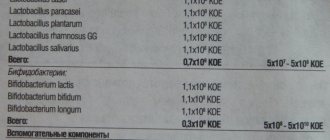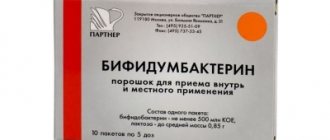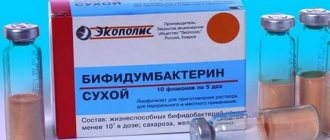"Biovestin-lacto" is a complex preparation containing representatives of normal human microflora - bifidobacteria and lactobacilli.
Contains a pharmacopoeial strain of bifidobacteria with high antagonistic activity against opportunistic and pathogenic microorganisms and resistance to therapeutic doses of the most common antibiotics:
- Bifidobacterium longum MS-42
In addition, Biovestin-lacto contains a pharmacopoeial strain of lactobacilli, known for its positive properties in the treatment of human dysbiosis:
- Lactobacillus plantarum 8P AZ
Description of pharmacological action
Dietary supplement to food - an additional source of bifidobacteria and lactobacilli. Biovestin-lacto is a complex probiotic. Contains bifidobacteria and lactobacilli - representatives of normal human microflora. Biovestin-lacto contains a strain of bifidobacterium Bifidobacterium adolescentis MC-42, which has high antagonistic activity against opportunistic and pathogenic microorganisms and resistance to therapeutic doses of the most common antibiotics. Since when a person is exposed to harmful environmental factors (increased radiation, stress, the use of chemicals in the food industry, the use of antibiotics and other chemotherapy drugs in medicine), as a rule, all representatives of the normal flora die, the composition of the Biovestin-lacto product, in addition to bifidobacteria, includes lactobacilli. In this case, a pharmacopoeial strain is used, known for its positive properties in the treatment of human dysbiosis - Lactobacillus plantarum. Due to the presence of several different microorganisms in Biovestin-lacto, the scope of application of this product increases and the effect of using this dietary supplement increases. The possibility of using Biovestin-lacto in complex therapy for intestinal dysfunction (diarrhea as a clinical manifestation of dysbiosis) has been shown; dysbacteriosis of various origins, caused by the presence of conditionally pathogenic intestinal microflora, to correct the microflora of open mucous membranes of the nasopharynx; during pregnancy; during prenatal preparation; long-term hormonal and radiation therapy; respiratory infections and their prevention; various manifestations of food allergies; iron deficiency anemia, vitamin deficiency conditions. Biovestin-lacto is compatible with medications, incl. with antibiotics.
"Biovestin-lacto" live bifidobacteria and lactobacilli
Additional information confirmed by voluntary certification.
Mandatory consumer information is placed on the packaging
Areas of use
- To prevent complications during antibiotic therapy, radiation and chemotherapy.
- To correct the immune status, including in HIV-infected people.
- To restore normal intestinal microflora, incl. nasointestinal probe and rectal endoscopic method.
- To normalize microflora and improve the barrier function of human mucous membranes.
- To improve the motor-evacuation function of the digestive system, restore the condition of the mucous membrane of the digestive tract.
- To restore the activity of the immune system in often long-term ill children, often ill people, after acute infectious diseases, during seasonal epidemic diseases.
- To prevent and reduce the severity of viral diarrhea.
- For inflammatory diseases of the genitourinary system (cystitis, pyelonephritis, bacterial prostatitis, bacterial vaginosis, chronic salpingoophoritis).
- To correct lipid metabolism.
- To reduce the external and internal toxic load on the body, incl. as a hepatoprotective agent.
- To protect against intoxication by harmful environmental chemicals.
- For chronic stress, winter fatigue syndrome, chronic fatigue syndrome.
- To increase endurance and sports performance in athletes of various qualifications.
Mechanisms of action
of the dietary supplement Biovestin is an additional source of bifidobacteria and promotes the restoration of symbiont microflora (SM).
Immunomodulatory
Symbiont microflora has universal immunomodulatory properties. The main immunomodulatory mechanisms are provided by bifidobacteria and lactobacilli. Colonization of the intestinal epithelium by bifidobacteria during interaction on the surface of M-cells of Peyer's patches leads to stimulation of lymphoid tissue, enhancement of innate immune reactions of the cellular and humoral immunity, and activation of cytokine production. Secretory IgA, produced with the direct participation of the normal flora of the mucous membrane of the genital tract and oropharynx, is an important factor in local immunity. Bifidobacteria, in addition to activating the production of IgA, stimulate phagocytosis and the formation of interleukins and interferons.
Regenerative (restoration of the intestinal mucosa)
SM metabolites take an important part in the life of the intestinal mucosa. Volatile fatty acids are a source of nutrition for mucosal cells, as well as an energy substrate for colonocytes. Butyric acid, butyrate, and estrogen-like substances are involved in the regulation of proliferation and differentiation of the epithelium of the gastrointestinal mucosa.
Metabolic
Violation of one of the functions of the intestinal microbiocenosis entails disturbances of various types of metabolism, contributing to the emergence of a deficiency of micronutrients - vitamins, microelements, minerals. SM ensures the synthesis of B vitamins, vit. K, folic acid due to its own synthesis. SM highly contributes to the modulation of the mineral metabolism of sodium, potassium, calcium, magnesium, phosphorus, chlorine, iron, zinc, manganese, selenium, copper, etc. SCFAs produced by SM as energy substrates occupy a significant place in the daily energy balance of a person.
Detoxification
Symbiont microflora (SM) inactivates toxins and microflora aggression factors, reduces histamine synthesis by inhibiting histidine decarboxylation, which helps reduce the content of endogenous toxins in the intestine. The metabolic products of SM and SCFA contribute to the suppression of putrefactive processes and suppression of the formation of ammonia, aromatic amines, sulfides, and endogenous carcinogens.
SM performs a detoxification function against many exogenous potentially toxicogenic substances supplied with food, water, and air. Such as salts of heavy metals, pesticides, nitrates, food additives and other xenobiotics. SM also acts as a “natural sorbent”, accumulating toxic products and preventing them from entering the portal vein system.
In addition, SM has antimutagenic activity.
Hypolipidemic
The components of SM metabolize FA and cholesterol with the formation of coprostanone, coprostanol, cholestenone through the hydrogenation reaction of the 5th and 6th double bonds of the cholesterol core.
Bifidobacteria, in the presence of bile salts, promote the transition of taurine and glycine-containing bile acid amides into poorly soluble precipitates that bind colonic cholesterol, which ensures its excretion with feces, and reduces the release of cholesterol from liver cells.
Anti-stress
The anaerobic component of the symbiont microflora is involved in the synthesis and regulation of neurotransmitters: alpha-alanine, 5-aminovaleric and GABA, glutamate, serotonin, dopamine, etc. SM through bacterial metabolites activates the synthesis of serotonin in the intestine.
Barrier (protective)
SM prevents the colonization of the intestinal mucosa by the PM and UPM by ensuring colonization resistance due to the competition of normal flora elements for adhesion sites, the production of corresponding metabolites - SCFA, bacteriocins, and competition for food substrates. The interaction of SM with the humoral and cellular components of mucosal immunity prevents the colonization of the mucous membrane of the genital tract by foreign microorganisms and prevents their translocation to other biotopes.
The same barrier mechanism also operates in the biotope of the mucous membrane of the oropharynx.
Bibliography:
1. Immunobiological drugs and prospects for their use in infectology / G.G. Onishchenko, V.A. Aleshkin, S.S. Afanasyev, V.V. Pospelov. - M.: State Educational Establishment VUNMC Ministry of Health of the Russian Federation, 2002.
2. Belousova E.A. Possibilities of lactolulose in the correction of intestinal microflora disorders / E.A. Belousova, N.A. Morozova // Pharmateka. -2008. ‐No. 1. -WITH.
3. Shulpeneva Yu.O. Excessive bacterial growth in the intestine: pathogenetic features and therapeutic approaches / Yu.O. Shulpeneva // RMJ. -2003. -T. 11. -No. 5(177). -P.281-284
4. Kalmykova A.I., Selyatitskaya V.G., Palchikova N.A., Bgatova N.P. Cellular and systemic mechanisms of action of probiotics. - Novosibirsk: Novosibirsk book publishing house, 2007. – 279 p.
5. Microbiocenoses and human health/edited by V.A. Aleshkina, S.S. Afanasyeva, A.V. Karaulova M., Dynasty Publishing House, 2015, 548 p.
6. Bondarenko V.M., Matsulevich T.V. Intestinal dysbiosis as a clinical and laboratory syndrome: current state of the problem. M.: GEOTAR-Media; 2006.
7. Doronin F.A., Shenderov B.A. Functional nutrition. - M.: Grant, 2002. - 296 p.
8. Current issues in the correction of intestinal microbiocenosis. Educational and methodological manual. St. Petersburg, 2012.
Bondarenko V.M., Matsulevich T.V. Intestinal dysbiosis as a clinical and laboratory syndrome: current state of the problem. M.: GEOTAR-Media; 2006.
9. Bondarenko V.M. The role of opportunistic bacteria in chronic processes of various localization / M.: Tver-Triad. – 2011; 88 p.
10. Shenderov B.A. Medical microbial ecology and functional nutrition. T.1: Microflora of humans and animals and its functions – M.: GRANT, 1998. -228 p.
11. Tkachenko E.I., Uspensky Yu.P. Nutrition, microbiocenosis and human intelligence. SPB.: SpetsLit-2006-590 p.
12. Arutyunov G. A., Kafarskaya L. I., Vlasenko V. K. et al. Intestinal biocenosis and cardiovascular continuum // Heart failure. – 2004.
13. Probiotics and prebiotics / World Gastroenterological Organization (WGO). Practical recommendations. 2008; 3. Petrov L.N. et al. Bacterial probiotics: biotechnology, clinic, selection algorithm / St. Petersburg: Federal State Unitary Enterprise Gos. Research Institute of OCB. – 2008; With. 31.
14. Grigoriev P.Ya., Yakovenko E.P. Violation of the normal composition of intestinal microflora, clinical significance and issues of therapy (methodological manual). -M., 2000. - 224 p.
15. Microbiocenoses and human health/edited by V.A. Aleshkina, S.S. Afanasyeva, A.V. Karaulova M., Dynasty Publishing House, 2015, 548 p.
16. Kulinenkov O.S. Pharmacological assistance to an athlete: correction of factors limiting sports performance. - Moscow: Soviet sport 2007. - 138 p.
How to open a bottle. How to dose the contents in drops
- Lift the cap cover according to fig. 1-2.
- Open from the side of the dotted notch on the cap.
- For drip dosing: pierce the membrane with two straws so that one touches the bottom of the bottle - fig. 4.
- Invert the bottle and dose according to the instructions, Fig. 5.
Dosing method
| Age | O - 3 months. | 3 months - 1 year | 1-3 years | 3-6 years | From 6 years and adults |
| Daily dose | 0.5 ml 10 drops | 1 ml 20 drops | 3 ml By mark or ¼ fl. | 6 ml By mark or ½ fl. | 12 ml 1/1 bottle |
Recommended daily doses are taken in 1-2 doses with meals.
The course of admission is 3-4 weeks. Before use, the contents of the bottle can be carefully mixed. To increase the effectiveness of use, it is recommended to take Biovestin 30 minutes before meals, or 1.5 hours after meals. Contraindications: individual intolerance to the components of the product, intolerance to milk protein. Consult your physician before use. Children from birth to 14 years old need to consult a pediatrician.
Storage conditions: store at a temperature of (4±2) C. When stored in the refrigerator, a consistency with single inclusions of milk fat or a fatty film is allowed. When opening the package, a slight release of carbon dioxide is allowed, due to the technology used to obtain the product. After opening, store in the refrigerator in a tightly closed bottle for no more than one day. Shelf life: 75 days from the production date in unopened original packaging.
Hotline “BIO-WESTS”. The call is free within Russia.
Directions for use and doses
Orally, 30 minutes before meals or an hour after, diluting or washing down the doses of Biovestin-lacto indicated below with a small amount of milk or water (with a temperature not exceeding 37–40 ° C). Do not add the drug to hot water or milk or store it in diluted form. Daily doses of Biovestin-lacto: children from 1 year to 6 years - 1 ml per year of life per day; children from 6 to 12 years old - 6 ml per day; children over 12 years old and adults - 12 ml per day. To protect the normal intestinal microflora during antibacterial therapy, the course of treatment is the entire period of taking antibiotics and up to 2 weeks after it. To correct intestinal dysbiosis, especially when accompanied by diarrhea, the course of administration is from 4 weeks to 4 months.
Reviews
Konstantin After chemotherapy, the entire body is weakened, and disruptions occur in the functioning of the gastrointestinal tract due to disruption of the microflora. I happened to survive cancer. The course of treatment was long and exhausting. I literally “melted” before my eyes. The probiotic Biovestin Lacto has helped me incredibly. A month later, I gained five kilograms, my bowel movements returned to normal, I had strength and appetite, and my skin color was not so frighteningly pale. The drug eliminated all the negative effects of chemotherapy and turned out to be effective. I took it for four months.
Tatyana I can safely call Biovestin Lacto the best domestically produced food supplement. The composition of perfectly selected beneficial bacteria quickly copes with intestinal problems, eliminates diarrhea, and improves immunity. The first time I became acquainted with a probiotic was when I was poisoned by street chebureks. The condition was terrible - terrible diarrhea, vomiting, headache, high fever. The product helped me on the second day. But I didn’t stop taking it, I took it for another month. The price is reasonable, the effect on the face, I recommend.
Best before date
24 months
Vitamins with similar effects
- VITABS Bio with bifidobacteria (Capsule)
- VITABS Bio with lactobacilli (Capsule)
- Biphenol (Capsule)
- Ozovit (Powder for oral use)
- Biomass of acidophilic lactobacilli "Narine" dry (BALB "Narine") (Biomass)
- Bactistatin (Capsule)
- Bion 3 (Oral tablets)
- Bifiform Baby (Oral solution)
The description of vitamin Biovestin-lacto is intended for informational purposes only. Before starting to use any drug, it is recommended to consult a doctor and read the instructions for use. For more complete information, please refer to the manufacturer's instructions. Do not self-medicate; EUROLAB is not responsible for the consequences caused by the use of information posted on the portal. Any information on the project does not replace consultation with a specialist and cannot be a guarantee of the positive effect of the drug you use. The opinions of EUROLAB portal users may not coincide with the opinions of the site Administration.
Are you interested in vitamin Biovestin-lacto? Do you want to know more detailed information or do you need a doctor's examination? Or do you need an inspection? You can make an appointment with a doctor - the Euro lab is always at your service! The best doctors will examine you, advise you, provide the necessary assistance and make a diagnosis. You can also call a doctor at home . Euro lab clinic is open for you around the clock.
Attention! The information presented in the vitamins and dietary supplements section is intended for informational purposes and should not be a basis for self-medication. Some of the drugs have a number of contraindications. Patients need to consult a specialist!
If you are interested in any other vitamins, vitamin-mineral complexes or dietary supplements, their descriptions and instructions for use, their analogues, information about the composition and form of release, indications for use and side effects, methods of use, dosages and contraindications, notes about the prescription of the drug for children, newborns and pregnant women, price and consumer reviews, or you have any other questions and suggestions - write to us, we will definitely try to help you.
Analogs
- Biphilis;
- Acylact;
- Lactusan;
- Colibacterin;
- Bificol;
- Lacidophilus;
- Laktomun;
- Liveo Children;
- Maxilac;
- Narine;
- Acidophilus;
- Sporobacterin;
- Maxibalance;
- Rotabiotic Baby;
- Bifidumbacterin;
- Yogulact;
- Complex Pro;
- Normobact;
- Rioflora;
- Bactistatin;
- Bioflor;
- Enterozermina;
- Biosporin;
- Trilact;
- Protoloans;
- Acipol;
- Lactobacterin.
Indications for use
Biovestin is not a drug; it is used in complex treatment and therapy in the following cases:
- For flatulence, diarrhea, constipation resulting from intestinal dysfunction.
- While taking antibacterial, hormonal medications, and during long-term radiation therapy.
- For ARVI and various relapses of food allergies.
- For iron deficiency anemia, iodine deficiency and hypovitaminosis.
- During pregnancy and for sanitation in preparation for childbirth.
- For dysbacteriosis of various etiologies, caused by the presence of pathogenic microflora in the human body.
The pharmacological action of the probiotic Biovestin is aimed at normalizing digestive functions (an effective remedy for constipation and diarrhea), boosting immunity, improving the absorption of vitamins and nutrients, an absolutely safe drug for both newborns from 3 months and infants, and for adult patients.
Storage conditions:
Biovestin Lacto is stored in the refrigerator for 75 days at a temperature of +2 +6 oC.
When storing Biovestin Lacto, a white film may appear on the inner wall of the bottle - milk fat residues. When the contents of the bottle are heated to room temperature, the film dissolves. Do not shake bottles with Biovestin and do not heat them above +40oC. Opened bottles are stored in the refrigerator for no more than two days.
If you give Biovestin to a baby under one year old (up to 1 ml per day), consume the remaining product in the bottle yourself. This will only benefit you.
Frequently ill children
Frequently ill people are not a figure of speech; pediatricians classify their young patients into this group if illnesses occur with a certain regularity. Such sick children are prescribed physical and hardening procedures and therapeutic exercises. And, of course, the recovery program includes the restoration of beneficial flora.
After taking antibiotics, the flora is seriously affected, and dysbacteriosis may develop. It is necessary to support beneficial strains of microorganisms in the intestines and get rid of pathogenic flora.











